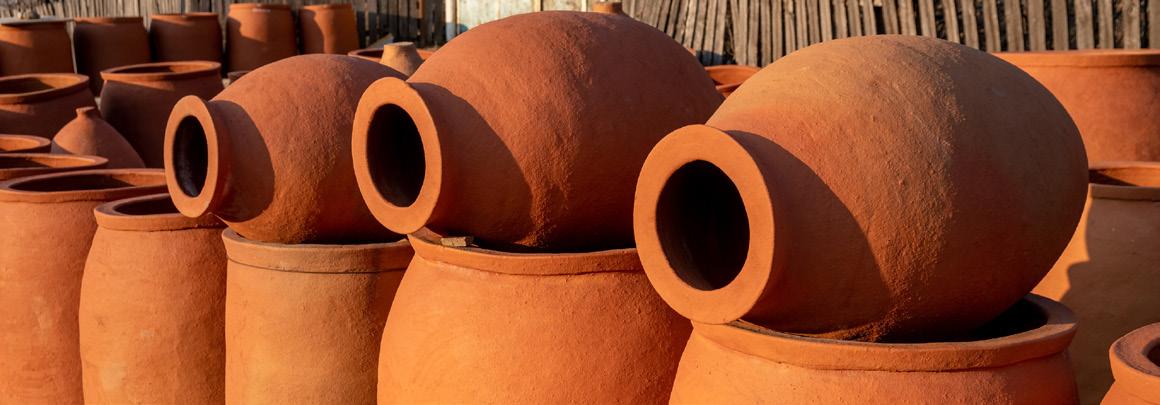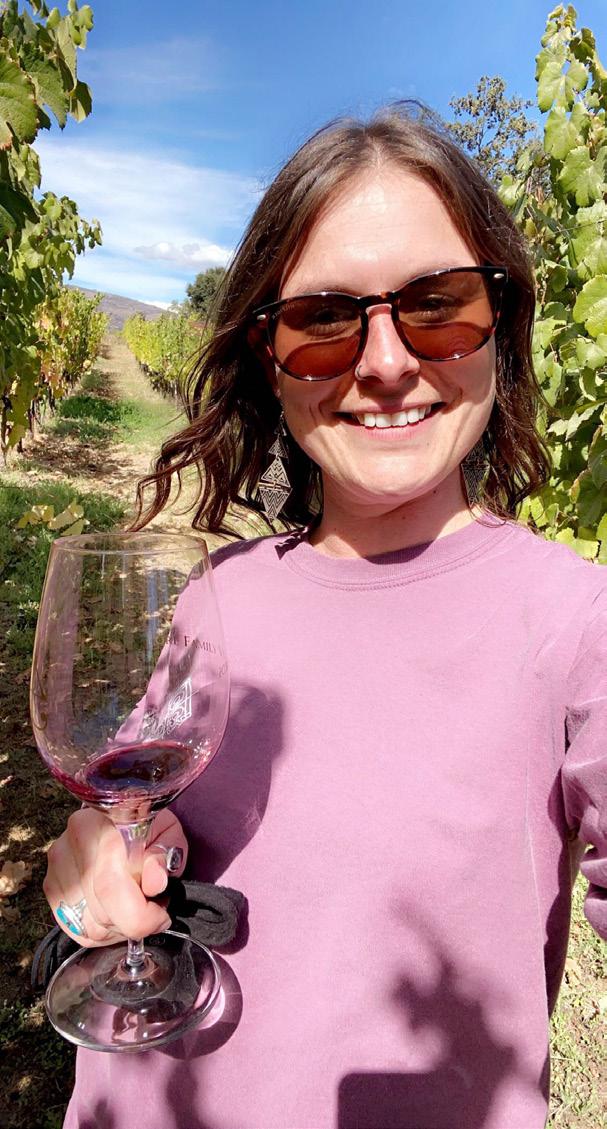
6 minute read
Wines
SPOTLIGHT ON: THE REPUBLIC OF GEORGIA
8,000 years! That’s how long the country of Georgia has been continually perfecting the art of winemaking. Unfamiliar with Georgian wines? Well, you won’t be for long. Georgia is experiencing a boom in both the production and exporting of wine post their 2008 war with Russia. During this period of regrowth, Georgia went from having 80 registered wineries in 2006 to almost 1,000 by 2018.
Advertisement

With 430 indigenous grape varieties, there is something for everyone when it comes to sampling Georgian wines. While most of the wines imported to the US are dry reds, about 70% of the 90 million bottles produced annually in Georgia are sweet to semisweet reds, which are meant to be consumed young and are brimming with dark forest fruit and spice notes with a clean (never jammy) finish. Perhaps most famous for their use of kvevri (pronounced “kway-vree”; lemon shaped clay pots up to 6 ft tall that are buried in the ground up to their necks and used for fermenting and aging wine), this ancient tradition was almost wiped out in the 20th century as Soviet tastes deemed these practices outdated, preferring the speed and efficiency of steel barrel production, and ultimately banning small, family winemaking. In secret kvevris kept in basements, families kept tradition alive and as the demand for low-intervention yet budget-friendly wine increases, so has the interest in this ancient art. Winemaking at its most simple, grapes are added to the kvevri and when the initial alcohol fermentation is complete, the kvevri is sealed, with the ground maintaining constant temperature, and not opened again until Spring, when the wine is removed. And while this process may sound straightforward, there is a true art to creating the perfect conditions to craft this beautiful and unique wine. Georgian wine, almost more than anywhere else in the world, is deeply connected to nature, family, and tradition and is well-worth seeking out. Interested in trying some Georgian wine? Splash has you covered! Check out Mildiani Family Winery Saperavi 2018 (Red) & Mildiani Family Winery Rkatsiteli 2018 (White)

WHAT THE HECK ARE SULFITES?
You may have heard people talk about sulfites like they are the big, bad villain of wine lovers’ nightmares. But before we get out the pitchforks and panic, let’s talk about what sulfites really are. Sulfites, also called sulfur dioxide, come in two types: natural and added.
Naturally occurring sulfites happen NATURALLY during the fermentation process and (guess what….) you can’t escape them! Ok, that sounded slightly more ominous than it should have. But unless you have sulfite allergies, you probably unknowingly consume sulfites pretty frequently with no ill side-effects (think lemon juice, sauerkraut, dried fruits, molasses, pickles, pizza crust, French fries and on and on). Sulfites are actually super beneficial. Sulfites are a natural preservative. Without them, the wine you love wouldn’t just be undrinkable, it would be a microbial-laden, swamp of sadness. Saving a bottle to open on your 25th anniversary? Yeah, without adding additional sulfites, it would be vinegar at best and a trip to the hospital at worst. Added sulfites are a winemaker’s best friend- they kill off unwanted bacteria and yeast and allow wine to ferment without going bad.

If sulfites are so great, what’s with all the bad press and rumors? Let’s set a few things straight: 1. You probably don’t have an allergy to sulfites (less than 1% of the population has a true sulfite allergy and the majority of those who do have asthma symptoms triggered by exposure). So, if you don’t have an allergic response to shrimp (which contain more sulfites per serving than an entire bottle of Sangiovese), you are probably fine with sulfites. 2. As much as I want to blame my red wine headache on sulfites- they simply aren’t to blame. Like all alcohol, drinking too many glasses can lead to dehydration and headaches. Also, it’s more likely that histamines (which occur naturally as part of the fermentation process) are to blame.
If you are histamine intolerant, you may get headaches (and tummy troubles or hay fever symptoms) from any high-histamine food, like parmesan, tomatoes, spinach, etc.
So, why are wines required to have the label “contains sulfites” if they aren’t harmful to your health? Starting in the 1970s, anti-alcohol lobbyists worked relentlessly to vilify wine and they decided to use fear-mongering tactics around the lack of public understanding of sulfites and a slight rise in people with serious sulfite allergies to make sulfites the big, bad wolf. In 1987, they succeeded in passing a law requiring “contains sulfites” on wine labels if the product contained more than 10 PPM (parts per million) and banning wine with more sulfites that 350 PPM (on average, wine has about 80 PPM). If sulfites were truly problematic, all sulfite containing foods would be required to have the same label. Can you imagine that healthy pouch of organic, dried fruits having a massive label saying “CONTAINS SULFITES” (for the record, dried fruit contains 3500 PPM on average, about 40x the amount of wine).
MEET THE TEAM
CASSIE, CUSTOMER SERVICE REP
CASSIE, WALK US THROUGH YOUR DAY “I always like to start my day with a clear mind and a positive attitude. I look forward to assisting our customers, even if it’s a tough cookie to crumble. I pride myself on finding a way to solve any issue and always try to find a way to make our customers happy and feel like I made their needs/requests a priority. I leave every day with a happy heart and smile on my face knowing I have been an easy resource for our customers to get what they need!”

TELL US A LITTLE MORE ABOUT YOURSELF OUTSIDE OF THE OFFICE… “I have always been a family-oriented person. I love to adventure with my 10-year-old yellow lab, family, and friends any chance I get! Camping is my favorite thing to do, but I have a new hobby I’m hoping to master, which is the electric guitar...I still have a long way to go. Another passion I have is acrylic flow art. It is so relaxing and satisfying to create. Each piece of art I create is different and that’s what I appreciate most about it.”
WHAT IS YOUR FAVORITE WINE WE HAVE AT SPLASH? “My favorite wine at Splash Wines so far would have to be the Angela Estate Pinot Noir. I love the hint of the fruit & spice and everything nice, all in one sip!”
WHAT IS YOUR FAVORITE PART ABOUT WORKING IN THE WINE INDUSTRY? “I would say my favorite part would be learning something new everyday. I enjoy that we sample all the wines and we help decide what to offer to our customers. I think wine is an art and I feel we are a small family rather than a small business and I am truly blessed to have such an amazing position at Splash Wines!”
WHAT IS THE BIGGEST THING YOU HAVE LEARNED FROM IT? “I would say communication and being honest. I feel that has always been my go-to with life. I also feel like I understand the science behind the process of wine being made and I had no idea before I started here at Splash Wines!”
WHAT IS YOUR FAVORITE FOOD TO PAIR WINE WITH THAT YOU USUALLY WOULD BE EMBARRASSED TO SHARE? “Surprisingly I enjoy eating sour gummies with a nice crisp glass of Sauvignon Blanc - I have quite the sweet tooth or maybe sour tooth? Ha Ha!”
WHAT IS YOUR FAVORITE MOVIE? Dazed & Confused
WHAT IS ONE RANDOM FACT ABOUT YOU THAT NOT VERY MANY PEOPLE KNOW? “I have moved to 4 different states in 1 year.”
WHAT IS YOUR GO-TO KARAOKE SONG? “Simple Man” by Lynyrd Skynyrd





